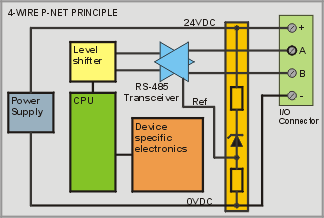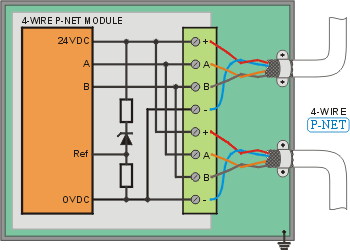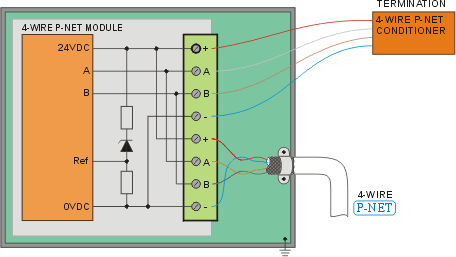4-Wire P-NET Topology
4-WIRE P-NET is a wiring principle that enables a number of simple devices to be connected by means of a single cable, which provides both communication and a power supply to all of them.
4-WIRE P-NET is always installed as a bus topology and must be terminated at both ends by a PD 990 4-WIRE P-NET Conditioner connected as a termination.
Traditional P-NET devices can be connected to a 4-WIRE P-NET network by including a PD 990 4-WIRE P-NET Conditioner unit, wired as 4-WIRE conditioner. See example.
A 4-WIRE P-NET bus segment can have a maximum length of 600 metres and contain up to 125 devices.
The cable for 4-WIRE P-NET must be a shielded type with 2 twisted pairs. One twisted pair is used for the supply of power – “power pair”, and one twisted pair is used for communication – “communication pair”.
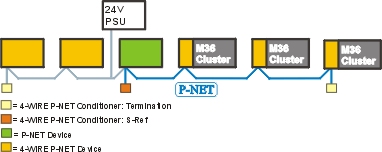
4-WIRE P-NET topics
Wiring examples
M36 cluster with local power supply for I/O
M36 cluster as bus power supply
M36 cluster with termination
4-WIRE P-NET termination
4-WIRE P-NET termination and power supply
Traditional P-NET device connected to 4-WIRE P-NET – bus powered
Traditional P-NET device connected to 4-WIRE P-NET – local power supply
Mixing 4-WIRE P-NET and Traditional P-NET networks
4-WIRE P-NET communication reference
4-WIRE P-NET is based on traditional RS485 with the additional special feature: the communication reference. In RS485, all devices must share a communication reference potential. In 4-WIRE P-NET this reference potential is derived from the supply voltage. This ensures that all devices refer to the same potential (with respect to ground), even if there is a voltage drop and voltage variations along the bus cable.
A traditional P-NET device can be included in a 4-WIRE P-NET system by using a PD 990 4-WIRE P-NET Conditioner to create the communication reference. For more details, please refer to: 4-WIRE P-NET connection to a traditional P-NET device.
In the M36 series, the BM 012 base module includes a communication reference circuit, which allows direct connection to 4-WIRE P-NET networks.
Integrated referenced circuit in BM 012 modules
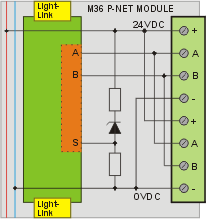
4-WIRE P-NET cable shield connection
The shield should be connected to ground (chassis) using a clamp, or in such a way that ensures an efficient high frequency connection. The shield connection should cover as large an area and have as low a resistance as possible.
The shield should be connected to ground as close to the cabinet cable entrance point as possible.
Never connect the shield to ground by a pigtail!
Where possible, the mounting plate of the 4-WIRE device should be connected to ground.
4-WIRE P-NET device without ground connection
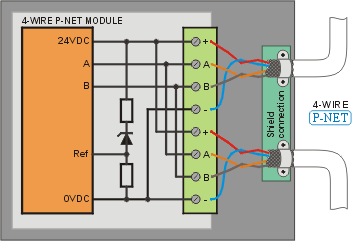
If the device cabinet is isolated from ground, the connection terminal area must ensure a good connection between the shields of the two bus cables.
4-WIRE P-NET bus termination
A 4-WIRE P-NET net segment must be terminated at each end. Termination is achieved by connecting a PD 990 4-WIRE P-NET Conditioner to the first and last node in the network.
The termination serves two purposes. It prevents signal reflections and applies a bias voltage to the A and B wires. The terminator resistor will absorb the signal as it reaches the end of the bus cable, thus avoiding reflections. The bias voltage ensures that a well-defined signal level is present on the communication wires when communication is inactive (bus idle).
4-WIRE P-NET termination at M36 cluster (BM 012 module)
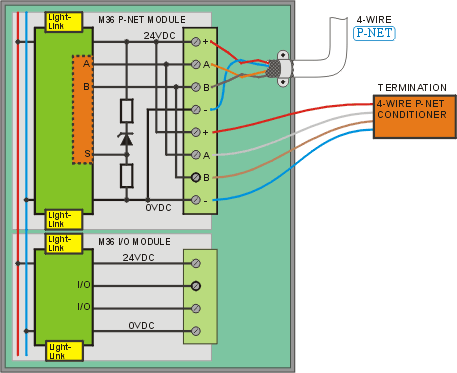
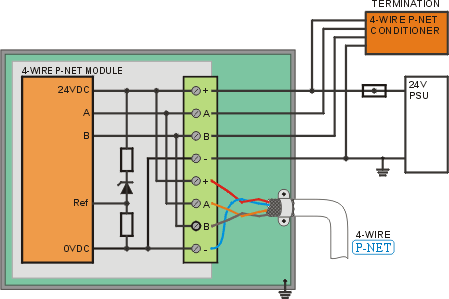
4-WIRE P-NET device connected to 4-WIRE P-NET including termination and power supply for the bus.

